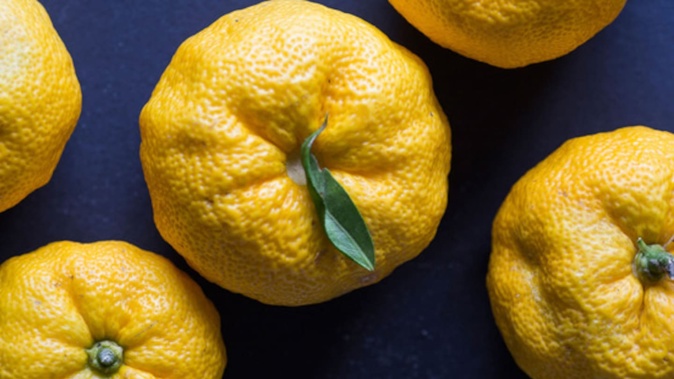
If you’ve noticed yuzu’s telltale tang cropping up in everything from dressings to chocolate bars, you’re not imagining it. Yuzu is officially having a moment. This knobbly, aromatic citrus native to Japan seems to have officially made the leap into the mainstream.
What is it exactly? A hybrid of sour mandarin and another citrus variety, Ichang papeda, yuzu is prized less for its flesh than for its zest and juice. The flavour sits somewhere between lemon, grapefruit and mandarin – bright, floral, slightly bitter – which makes it as versatile as it is intriguing.
While fresh yuzu is still relatively rare in New Zealand – it doesn’t grow easily outside Japan, Korea and parts of China – imported juice, puree and zest are becoming more accessible. A bottle of yuzu extract, once found only in commercial kitchens, is now available at speciality grocers and Asian supermarkets.
What’s changed is how it’s being used – not just in high-end kitchens but in supermarket aisles and home pantries. In recent years, yuzu has popped up increasingly in boutique tonics and non-alcoholic drinks, in beer, dressings and condiments (we’ve seen a yuzu hot sauce in Farro Fresh and, hello, yuzu mayo), plus yoghurts, kombucha and sweets. Duck Island had a pineapple and yuzu lime sorbet last winter; yuzu KitKats remain a cult import via speciality online stores; and New Zealand liquor brand Scapegrace worked with local yuzu farmers to create a yuzu vodka.

Yuzu lends itself beautifully to cocktails - Scapegrace made it even simpler by producing a yuzu vodka.
On menus, yuzu has long been a favourite in modern Japanese restaurants – Masu, Cocoro and Azabu have all featured it in everything from sashimi dressings to cocktails. Cocoro’s chef Makoto Tokuyama has championed citrus-forward sauces for over a decade, layering them into raw dishes where balance is key. But its appeal now stretches beyond the confines of Japanese cuisine. Auckland bars are increasingly featuring the citrus in cocktails and it’s not unusual to see it on a contemporary restaurant menu.
So why the obsession? Partly, it’s the flavour – complex and grown-up without being sour in a harsh way. But it’s also the timing. As New Zealanders embrace more Asian-influenced flavours and continue their post-pandemic fascination with “elevated pantry staples”, yuzu hits the sweet spot. Premium, but still accessible. It offers a sense of global flavour without requiring long explanations or unfamiliar techniques.
The beauty of yuzu, though, is that it doesn’t require much to make an impact. Unlike other trend ingredients that demand commitment (see: miso caramel, truffle oil), a dash of yuzu juice is enough to transform a dish. A few drops in soy sauce turns it into ponzu. A splash in olive oil creates an instant salad dressing. It lifts mayonnaise, cuts through fatty meats, and turns an ordinary sorbet into something you might find on a tasting menu.
You don’t need much to start experimenting. A bottle of yuzu juice in the fridge can brighten salad dressings, perk up a G&T or lift a pan sauce. Stir a few drops into soy sauce, or add a splash to a vinaigrette. For the ambitious, yuzu curd or a yuzu olive oil cake are crowd-pleasers that taste more complex than they are. Even something as simple as yuzu marmalade on toast can feel like a small indulgence.
In Japan, yuzu has long been used not just for culinary purposes but medicinal and cultural ones. During the winter solstice, it’s tradition to bathe in hot water with whole yuzu fruits floating on the surface – a custom believed to ward off illness and promote health. While you may not find Kiwis climbing into citrus-scented tubs just yet, there’s no denying the fruit’s mystique adds to its appeal.
For now, yuzu remains a little bit niche – but that might be the secret to its charm. A citrus with an air of mystery.
Take your Radio, Podcasts and Music with you









